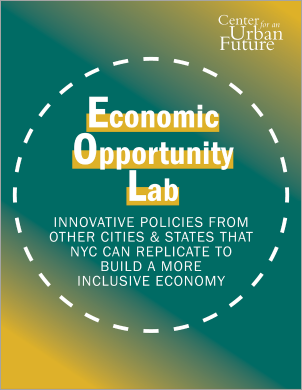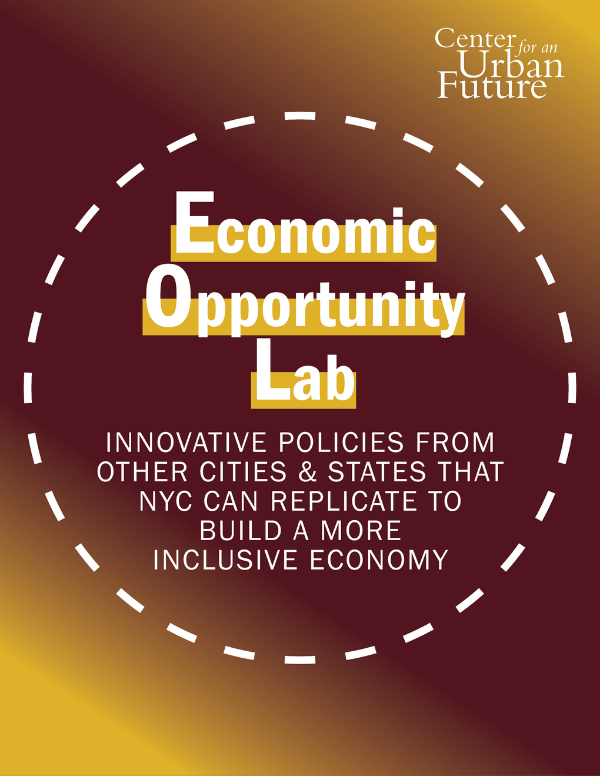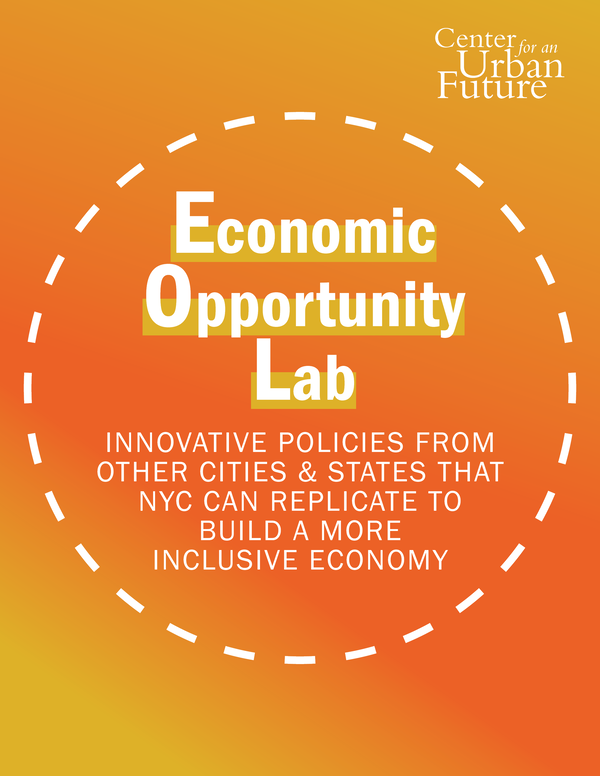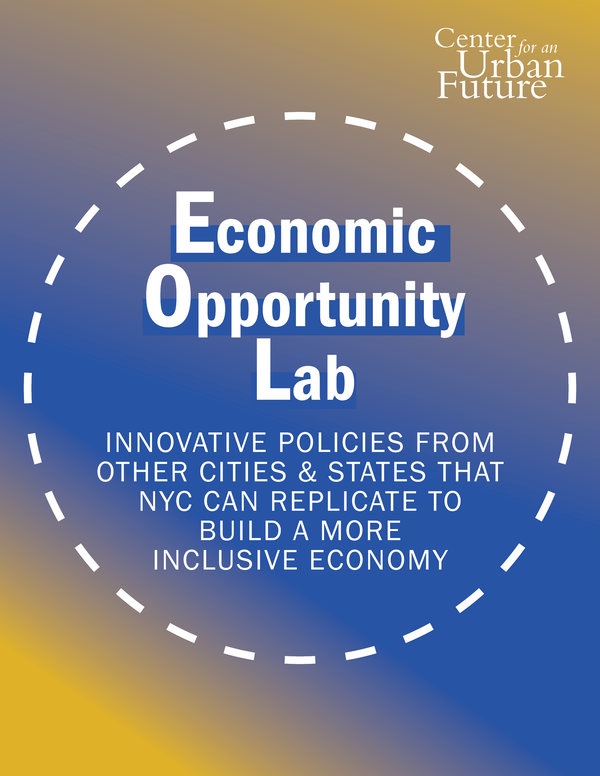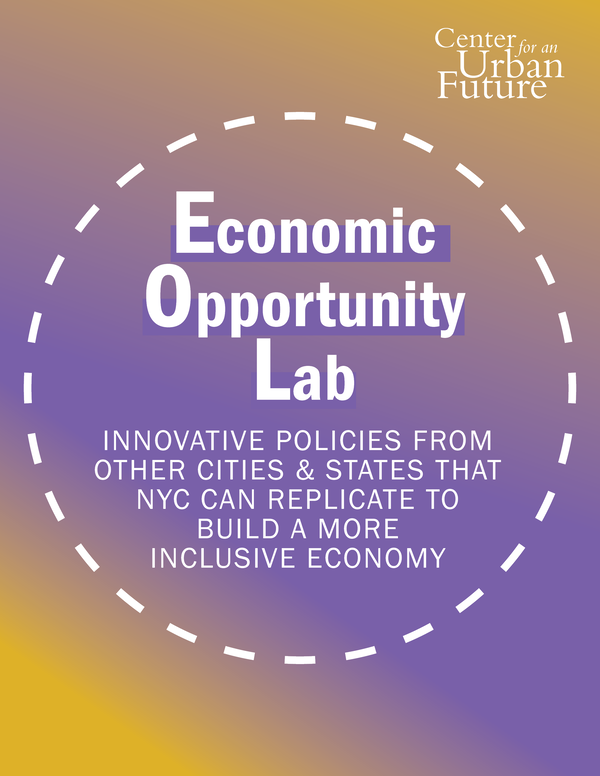
Each year, New York City takes in more than $2 billion in fines, forfeitures, and fees—for everything from parking tickets and building code violations to street vendor infractions and turnstile hopping to credit card processing charges and fingerprint fees.1 These fines and fees provide the city with revenue, with some financial penalties intended to serve as a deterrent. However, many of these charges either disproportionately fall on lower-income New Yorkers of color or prove especially destabilizing for those New Yorkers without the means to absorb the cost. As city policymakers look for ways to create a more equitable economy, leaders should seize the opportunity to reform a system of fines and fees that has the most severe consequences for those New Yorkers least able to afford them.
Mayor Adams, Comptroller Lander, and the City Council should look to San Francisco’s Financial Justice Project (FJP), which since its creation in 2016 has successfully eliminated and adjusted dozens of fees and fines. The city’s innovative municipal initiative has done away with water shutoff fees, reduced boot removal fines by 80 percent, created payment plans for low-income residents who receive parking violations, piloted a program to reduce child support debt, waived $32 million in criminal justice debt, and cleared 88,000 holds on driver’s licenses.
Launching a similar program in New York could bring significant financial relief to tens of thousands of low-income New Yorkers of color. Today, New York City levies a broad array of fines and fees on residents, many of which disproportionately fall on lower-income New Yorkers and people of color. New York City’s courts impose mandatory surcharges on anyone convicted of a crime, totaling over $13 million annually in fees for non-felony charges alone, adding a financial burden on top of court-mandated fines, jail time, and other penalties.2 Even after release, New Yorkers on parole are charged a $30 per month supervision fee, further penalizing Black and Latinx New Yorkers who are more likely to be incarcerated and remain on parole longer than white New Yorkers in similar situations.3 In some cases, the enforcement of fines adds financial penalties on top of preexisting poverty, driving cycles of incarceration and debt. For instance, New Yorkers in neighborhoods with the highest poverty rates are more than twice as likely to be stopped for turnstile jumping—which carries a $100 fine—as those in the rest of the city.4
In addition to the millions in fines and fees that primarily affect low-income New Yorkers, the city levies millions in additional fines and fees without consideration of the recipient’s ability to pay. The penalty for installing a business sign that does not meet the city’s regulations is at least $800 to $1,250—a minor expense for a larger company or chain retailer but a major burden for a small business in a lower-income neighborhood. Even a $60 no-parking ticket can have a drastic impact on the life of a New Yorker who is already struggling to make ends meet—and the cost is fixed whether the ticketed vehicle is a luxury car or a scooter. Some fees do not even result in revenue for the city. For instance, it costs up to $11.95 to make a single money transfer to a person held in one of New York City’s detention facilities—a fee that goes to a private corporation.5 New fines and fees introduced during the COVID-19 pandemic have only exacerbated the racial and class discrimination inherent in fines and fee enforcement; while Black and Latinx residents make up half of the city’s population, they received 81 percent of tickets issued for failing to social distance, according to data released in May 2020.6
Whether fines and fees directly target lower-income New Yorkers or simply have a more destructive effect on the lives of New Yorkers with the least ability to pay, the time is ripe for a systematic reexamination as policymakers seek to rebuild a more racially just city in the wake of the pandemic. “The brunt of these fines and fees are levied on Black and brown communities,” says Antonya Jeffrey, New York director of the Fines and Fees Justice Center, a national organization that advocates for reducing unfair and discriminatory fines and fees. “You’re extracting wealth from the communities that need it.”
The Adams administration has already taken steps toward reforming some city-imposed fines. On his fourth day in office, Mayor Adams signed the “Small Business Forward” executive order, which established an Inter-Agency Working Group to review and reform compliance costs for businesses. The order directs different departments to reduce fine schedules and allow for cure periods or warnings for first-time violations—and requires departments who choose not to pursue reform to provide sufficient reasons. This initiative complements other recent efforts spearheaded by the City Council, including the 2019 Awning Act fine moratorium for small businesses and a 2018 bill that eliminated fees for phone calls from city jails.
Now city leaders should go further to understand and rectify the most inequitable effects among the thousands of fines and fees currently on the books, with a focus on fines and fees other than those aimed at protecting lives (such as life-threatening conditions on building sites or major health code violations in restaurants). Indeed, many of the same communities hit hardest by the economic impact of the pandemic are also those most adversely affected by the design and enforcement of these revenue raising mechanisms. To address this, city leaders should look to San Francisco for inspiration and launch a new interagency effort to reform or eliminate those fines and fees with the most harmful impact on lower-income New Yorkers and communities of color.
The Policy
After the murder of Michael Brown by a police officer in Ferguson, Missouri, the U.S. Department of Justice published the Ferguson Report, which described how minor municipal code violations, such as trash-removal citations, parking tickets, and Derelict Auto violations resulted in “multiple arrests, jail time, and payments that exceeded the cost of the original ticket many times over” for more low-income people of color with every passing year, as law enforcement and other agencies sought to maximize revenue.
A group of five California-based legal services nonprofits responded to the Ferguson Report with a report of their own, Not Just a Ferguson Problem: How Traffic Courts Drive Inequality in California (2015), which focused on the four million Californians whose driver’s licenses had been suspended, making it “hard for [them] to get and keep jobs, harm[ing] credit ratings… and ultimately keeping people in long cycles of poverty.” This report, in turn, helped spur the City of San Francisco to create a Fines and Fees Task Force in November 2016, charged with examining and mitigating the impact of financial penalties on low-income people of color.
The taskforce evolved into the Financial Justice Project, a government initiative led by San Francisco Treasurer José Cisneros—an elected official similar to New York City’s comptroller—and San Francisco’s first-ever director of financial justice, Anne Stuhldreher. FJP is the first program in the nation to be directly embedded in government with the mission of assessing and reforming fines and fees that disproportionately affect lower-income residents. It is comprised of nine representatives from city agencies and four “community seats” reserved for local advocates.
FJP began by hosting public hearings and less formal listening sessions with community groups, and conducting research on the inequity of fines and fees. The team found that “in San Francisco, the burden of these fines and fees falls heavily on the African American community.” For instance, Black residents make up less than 6 percent of the city’s population, but account for 45 percent of those arrested for a “failure to appear/pay” traffic court warrant and 70 percent of those seeking legal aid for suspended driver’s licenses.
“We looked at what happened when people couldn’t pay these fines and fees,” explains Stuhldreher. “Their credit score can be impacted. Their license can be suspended, not for dangerous driving, but because they simply couldn’t pay their bill. Without a driver's license, it's very hard to get a job or get into an apartment. It's hard to do much of anything.”
For each fine the taskforce studied, they typically recommended one of three solutions: eliminating the fine altogether, basing the fine amount on a person’s ability to pay, or offering non-monetary alternatives to payment. City agencies across San Francisco went on to implement dozens of FJP’s recommendations and studied their efficacy.
For example, the Financial Justice Project partnered with the San Francisco Department of Child Support Services to launch a pilot program for parents who had fallen behind on child support payments. In 2016, 12,000 San Franciscans—primarily fathers of color with household incomes of less than $10,000 a year—owed the city money for the time their child was on public assistance in the absence of regular child support payments. Now, the Compromise of Arrears Program (COAP) assesses parents’ ability to pay off their debt based on their income, reduces debt accordingly, and allows partial payments to be made over a period of 36 months. An Urban Institute study of early participants, including 30 fathers and two mothers, found that payment rates increased from 18 to 28 percent, and that debt relief resulted in reduced barriers to employment and improved credit scores, as well as stronger relationships between coparents and children.7
The task force also recommended alternatives to fines for people experiencing homelessness and housing insecurity who have been cited for infractions like loitering or sleeping in public. The result is a new program, CONNECTion To Services, run by the District Attorney’s Office: people experiencing homelessness can now clear quality of life citations if they undergo 20 hours of social service assistance from any provider.
“Fines and fees are only one part of the civic toolbox,” Stuhldreher says. “You can wield other parts of the toolbox. You can hold people accountable in ways that do not put them in financial distress. You can balance your books in ways that are not on the backs of the most vulnerable folks in your community.”
The Challenge
1. Without top-level leadership from Mayor Adams and Comptroller Lander, as well as legislative action, individual government agencies and offices are unlikely to execute sweeping reforms.
The Financial Justice Project succeeded in San Francisco because it had the full backing of the city’s Treasurer and mayor. Leaders at the highest level of government made clear that fines and fees reform was a priority for creating a more equitable city.
In New York, city agencies and other civic institutions have individually attempted to reform their fine and fee structures with varying success. All three New York City public library systems eliminated late fines in 2021. After canceling the city’s 2020 property tax lien sale as a result of the pandemic, city leaders are now exploring alternatives to help lower-income homeowners retain ownership—rather than see their debts sold to private collectors. In recent years, the city has also overseen a notable decrease in the number of New Yorkers arrested for marijuana violations over the past decade, although arrest data shows that Black and Latinx New Yorkers were still disproportionately targeted.8
Today, there is no single entity charged with tracking and analyzing the effects of city-controlled fines and fees across agencies or holding agency officials accountable for proposing reforms. Effecting lasting change will require cross-agency coordination and accountability, as well as top-level leadership. In order to generate results, a New York City adaptation of San Francisco’s Financial Justice Project will need a similar level of executive support.
2. Better data collection and analysis capabilities will be needed to assess the impact of current and proposed fines and fees.
Unlike San Francisco, in New York City there are no public-facing audits or financial tracking mechanisms to transparently monitor who is being fined or where the revenue generated by their fines ends up. A lack of accurate information has made it difficult for legislators to accurately estimate how the removal or reduction of certain fines and fees might impact revenue, making it difficult, in turn, to advocate for reform.
Even in San Francisco, the Financial Justice Project encountered challenges collecting data from departments with antiquated systems or few staff. Particularly after their first year of implementation, San Francisco found data collection to be a major barrier to implementing more effective policies.9
New York City should anticipate this challenge out of the gate and link the creation of a fines and fees reform process with new efforts to bolster the data collection and analysis capabilities of city agencies—or pass legislation to compel more actionable disclosures. In addition to improving data collection and analysis practices and making more data publicly available on the impact of fines and fees by neighborhood and demographic factors, city leaders should consider mandating an impact assessment of the effect of existing and newly proposed fines and fees on lower-income New Yorkers of color. Finally, the NYC Comptroller should consider following the lead of San Francisco Treasurer Cisneros by launching an NYC Financial Justice Project tasked with identifying and proposing remedies for a wide range of fines and fees that disproportionately impact lower-income New Yorkers of color.
Conclusion
Despite the obstacles to overcome, the future for fine and fee reform in New York City is ripe for change. The city has already made headway: implementing free phone calls from city jails and forgiving debt for more than 50,000 students through CUNY’s $125 million Comeback program. At the state level, New York’s Driver’s License Suspension Reform Act followed San Francisco’s lead in ending the suspension of licenses for drivers who could not afford to pay fines and fees, and providing income-adjusted payment plans for unpaid tickets. But there is far more work to be done.
As Mayor Adams, Comptroller Lander, and the City Council examine new ways of strengthening the city’s lower-income communities of color and rebuilding a more just and equitable city in the aftermath of the pandemic, policymakers should launch a Financial Justice Project embedded directly in city government and modeled on San Francisco’s successful initiative. Like in San Francisco, this project could be led by Comptroller Lander, who holds an office similar to that of San Francisco Treasurer Cisneros. Next steps should include working with state legislators to eliminate mandatory surcharges and other court fees adopted to raise revenue and forgive outstanding debt owed to city courts; piloting fine schedules based on the recipient’s ability to pay; and developing new data collection and reporting requirements that can better illustrate the disproportionate impact of fines and fees. By taking action to reform the design and enforcement of fines and fees, city officials can put money back in the pockets of New Yorkers who need it the most and chart a path forward for a more just system of revenue raising policies in the future.
1 Center for an Urban Future analysis of data from the NYC Office of Management and Budget, “Adopted 2022 Financial Plan, Revenue”.
2 Office of NYC Comptroller, “Fees, Fines and Fairness,” September 2019.
3 Columbia University Justice Lab, “Racial Inequities in New York Parole Supervision,” March 2020.
4 Community Service Society, “The MTA’s False Fare Evasion Narrative,” January 2020.
5 JPay, “New York City Department of Correction: Rates”.
6 NBC News, “Pattern of uneven social distancing enforcement coming into view, civil rights experts say,” May 2020.
7 Urban Institute, “Relief from Government-Owed Child Support Debt and Its Effects on Parents and Children,” August 2019.
8 The City, “Black and Latino New Yorkers Hit With Brunt of Pot Arrests,” March 2021.
9 The Financial Justice Project, “Advancing Financial Justice in San Francisco,” May 2020.
